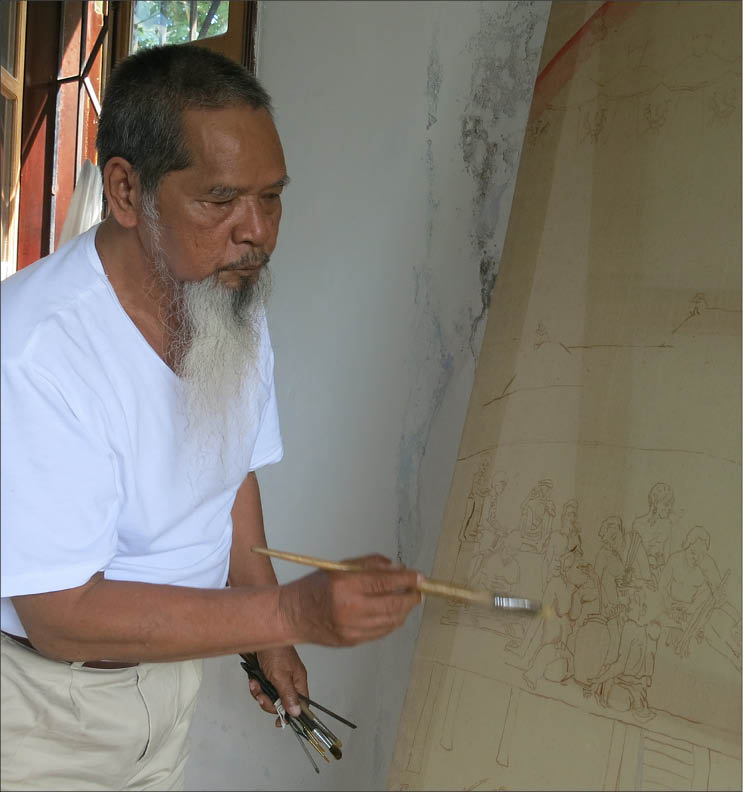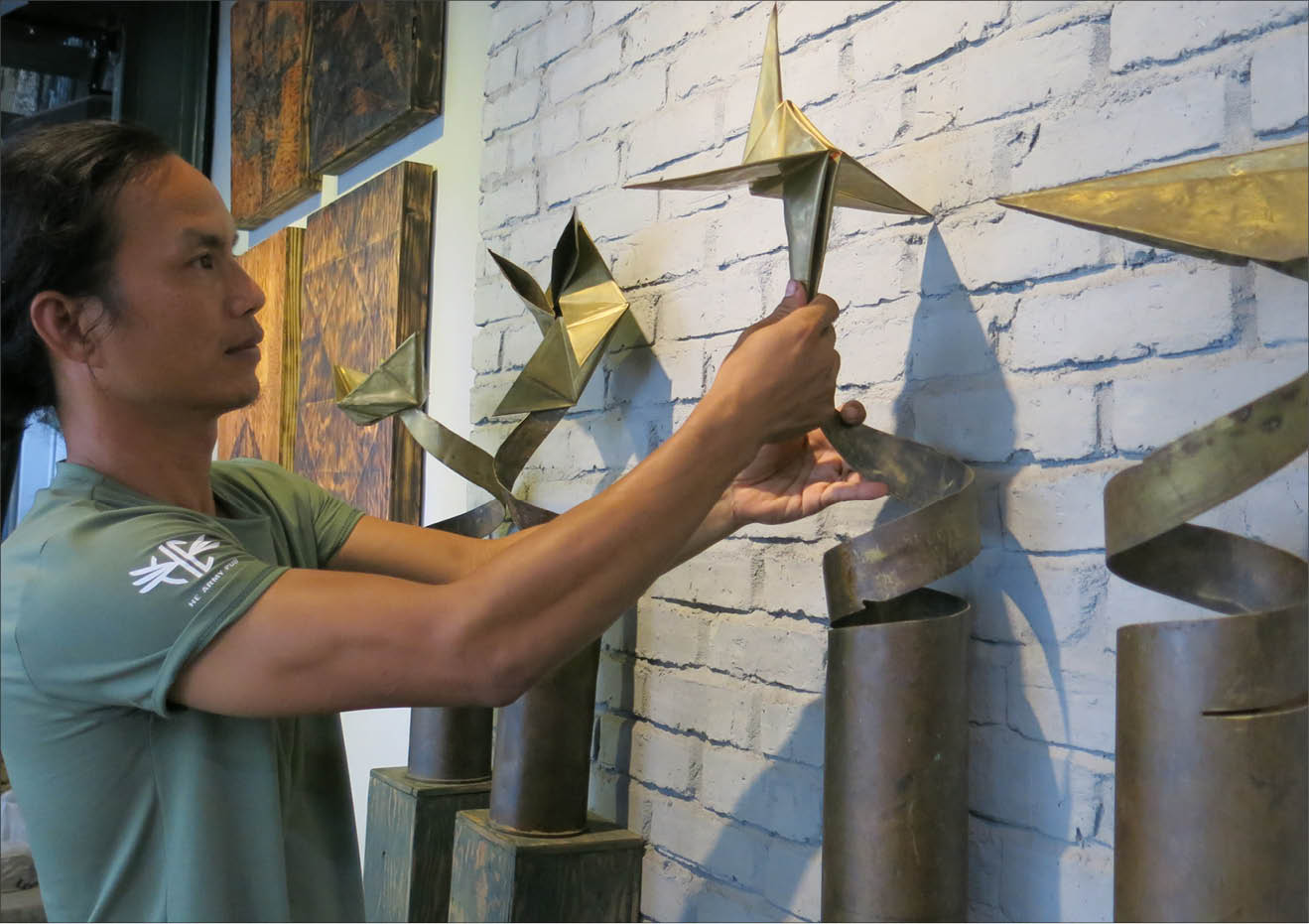In 1957, Le Minh Kai, the 10-year-old Co Tu child left his hometown A Luoi, following Truong Son Road to the North. With his gift for art, he studied sculpture at Vietnam University of Fine Arts. Since he went through the war against the U.S., the fierceness of the war was inscribed on Kai's mind. His works about the war helped his name enter the Circle of Vietnamese sculptors.

Le Minh Kai with his work “Uncle Ho and Ethnic Peoples in A Luoi”
His “Sounds of Tay Nguyen Gong” (1970) has entered the history of Vietnamese modern fine arts and is now kept at Vietnam Museum of Fine Arts. The image of a vigorous Tay Nguyen (western highland) man holding up a gong as the mountains and forests had wakened up, showing the heroism of Tay Nguyen people during the resistance years.
“The inspiration for ‘Sounds of Tay Nguyen Gong’ appeared when I read the novel ‘The Rising Nation’ by Nguyen Ngoc. It reminded me of the sounds of the gong in my hometown. For Tay Nguyen people, the sound of gong is a treasure. It is resounded in happy singing moments, in praising for a victory, or in calling for people to fight the enemy, urging even people both in caves and on mountains,” said Le Minh Kai.
When the U.S. bombed Hanoi, Le Minh Kai escaped death narrowly. That incident inspired him to paint “Stronger than Bombs” (1972) with the image of a female guerrilla holding ‘ban chong’ (spikes) in a strong and challenging manner. Although the U.S. dropped tens of thousands of bombs, ethnic people were not frightened. They fought against the enemy with spikes and traps, using guerrilla tactics. To Huu, the poet and Great General Vo Nguyen Giap liked the painting very much. It is now kept at Vietnam Museum of Fine Arts.
Back home, Le Minh Kai pursues the theme of his homeland and the life of his people with images such as people working on the farm, buffalos returning to the village. Especially he draws with respect paintings of Uncle Ho. The fact that he had met Uncle Ho twice in Hanoi was the inspiration for him to paint “Uncle Ho and Ethnic Peoples in A Luoi” on silk.
Le Minh Kai does not make many statues, but his works are all impressive as a critic commented: “Each work leaves a personal impression, revealing the soul of Ca Tu people full of love for life. He used modern shapes to freely express his feelings.” Until now, he has still been passionate about art: “As I get older, my childhood memories of the days living with bombs and bullets come back. I want to record the past wars with the sacrifice and devotion of my friends and fellow men.”
Expressing post-war pain
Born in the peacetime, Nguyen Van He had no experiences of war, but he witnessed its fierce consequences in the post-war time. He was born in Hoa My Base. His early years were spent with bombs and bullets. His childhood memories were therefore about the days he went collecting war scrap metals.
“At that time, almost 90% of the people in the village, including my family, collected war scrap metals. I witnessed many people get hurt or even lose their lives due to bombs and mines. When my uncle died in a bomb explosion, I was so painful and scared that I did not dare to touch any war scrap metals with which I had often played,” said He.

Nguyen Van He with his work “Game”
When He attended College of Arts, Hue University, he painted those memories unconsciously in classes. Whatever he drew, it was about wars. Not until his graduation did he realize the war was the recurring and obsessing theme that lay deep in his mind.
“Coming back home after graduating from college, one afternoon, I shuddered to hear bombs and mines exploding. I suddenly recalled the old memories and realized that they were what I had painted so far. From then on, I have painted on this theme,” He said.
Most of Nguyen Van He's paintings are about the war whether they are installation art, oil paintings or lacquer paintings. However, his works do not reflect the reality of the war itself. He employs new art techniques to condemn the war. With “The Sorrow of War”, which won a prize from the Vietnam Fine Arts Association, he wanted to imply that the war caused pain to women with the image of a woman who was tied firmly and stiflingly on a bomb hole.
Nguyen Van He’s latest work is the set of installation arts “Game” made from war scrap metals. He folded cannon ball shells into innocent children’s toys such as cranes, airplanes, etc., to get across the message “War is just a game that causes suffering to people. I want to turn suffering into happiness,” said He.
When he has children, it hurts him a lot when his children are sick. He thinks of children in many parts of the world who are being torn by wars. His series of paintings “Starting Labor," "Earth" and "Water" came into being. The image of a man with his child on his back holding a rifle in hand looking at the sky with the moon is his dream of a peaceful space with no war on this earth, so that children are no longer obsessed with wars as he is.
Story and photos: TRANG HIEN